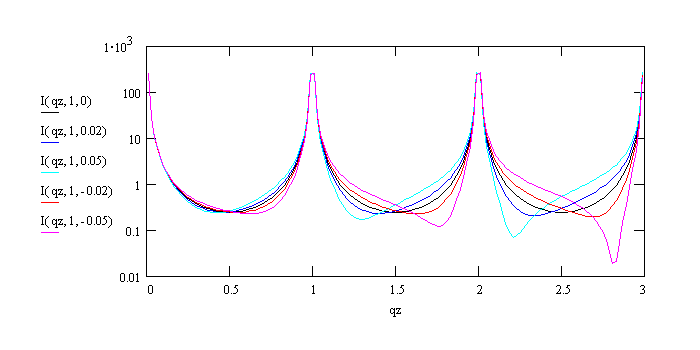
Crystal Truncation Rods
The crystal truncation rods have more interesting features: The diffuse scattering has a well-defined phase with the substrate Bragg reflection superimposed a perfect gauge marks. Hence we can use the CTR's as reference for interferometry, in order to determine the position of the surface layers above the top layer of the substrate with high precision. As long as we go deep enough into the substrate we will reach a layer with the ideal bulk structure. Substrate layers above this reference layer we will make part of our surface model, which now contains the actual surface layer as well as the layers distorted due to the presence of the surface layer. Experience from surface science is that not more than 2-3 substrate layers, in semiconductors sometimes up to 5 substrate layers, get distorted.
Now let us look into some specific problems. The top layer of a metal
is typically weaker bound to the underlying layer than two atomic layers
in the bulk, due to the fact that the electrons at the surface can spill
out somewhat into the vacuum. As a result, the outermost layer spacing
is enlarged, which is usually referred to as relaxation. If hydrogen, almost
invisible to x-rays, is absorbed on a metal surface, the electrons are
more tightly bound again and the relaxation is reduced or may be even inward.
Below we show the effect of such a relaxed top layer on the CTR intensity.
Another effect on the CTR is the density of the top layer. The density
of the top layer can be varied by replacing atoms by either higher Z or
lower Z atoms including vacancies (Z=0). The picture below shows that the
intensity at the anti-Bragg position is enhanced for higher electron density
in the top layer and decreased for lower elctron density:
Vacancies in the top layer is a simple way to model roughness. Every real surface is never ideally flat: there are point defects like vacencies, line defects such as step edges and kinks, and even more complicated defect structures (an example would be a screw dislocation from the bulk ending in the surface). A simple roughness model that can often be applied, assumes an uncorrelated in-plane roughness such that the laterally averaged surface profile as a function of z looks like an error function with parameter s. The chapter Roughness shows how to derive the CTR intensity for a rough surface using the Fourier formalism. We show the result below. Note that it takes only roughness values on the order of a lattice constant to attenuate the CTR so strongly, that the intensity at the anti-Bragg condition cannot be determined any more: For the use of CTR's well-prepared surfaces according the surface science standards are a necessity.